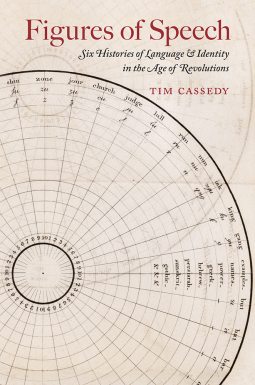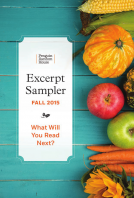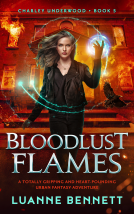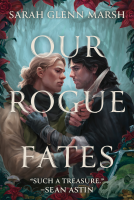
Figures of Speech
Six Histories of Language and Identity in the Age of Revolutions
by Tim Cassedy
This title was previously available on NetGalley and is now archived.
Send NetGalley books directly to your Kindle or Kindle app
1
To read on a Kindle or Kindle app, please add kindle@netgalley.com as an approved email address to receive files in your Amazon account. Click here for step-by-step instructions.
2
Also find your Kindle email address within your Amazon account, and enter it here.
Pub Date Jan 03 2019 | Archive Date Mar 01 2019
University of Iowa Press | University Of Iowa Press
Talking about this book? Use #FiguresOfSpeech #NetGalley. More hashtag tips!
Description
Tim Cassedy’s fascinating study examines the role that language played at the turn of the nineteenth century as a marker of one’s identity. During this time of revolution (U.S., French, and Haitian) and globalization, language served as a way to categorize people within a world that appeared more diverse than ever. Linguistic differences, especially among English-speakers, seemed to validate the emerging national, racial, local, and regional identity categories that took shape in this new world order.
Focusing on six eccentric characters of the time—from the woman known as “Princess Caraboo” to wordsmith Noah Webster—Cassedy shows how each put language at the center of their identities and lived out the possibilities of their era’s linguistic ideas. The result is a highly entertaining and equally informative look at how perceptions about who spoke what language—and how they spoke it—determined the shape of communities in the British American colonies and beyond.
This engagingly written story is sure to appeal to historians of literature, culture, and communication; to linguists and book historians; and to general readers interested in how ideas about English developed in the early United States and throughout the English-speaking world.
Advance Praise
“Tim Cassedy has one of the most nimble, creative, and curious minds among early Americanists today. The case studies in Figures of Speech are unexpected, fascinating, and brought strikingly (and often hilariously) to life in his writing. This book is a remarkable and rare achievement.”—Hester Blum, Penn State University
“In showcasing how figures like Duncan Mackintosh, Noah Webster, and Mary Willcocks experimented with linguistic innovations, Cassedy reveals how language can serve to preserve ties to a lost country or to fashion a new self in a foreign setting. I admire the strong narrative arc of each of the book’s chapters and also Cassedy’s sparkling prose style.”—Judith Pascoe, On the Bullet Train with Emily Brontë: Wuthering Heights in Japan
Available Editions
| EDITION | Other Format |
| ISBN | 9781609386122 |
| PRICE | $40.00 (USD) |
| PAGES | 296 |
Links
Average rating from 10 members
Featured Reviews
As a keen linguist, I found Figures of Speech a fascinating read. It's always interesting to consider both the development of language and the role it plays in any society. People such as Fry and Webster were already familiar to me; however, I had never heard the story of Princess Caraboo before, so that was a fun discovery. Although it was always insightful, I did find Cassedy's prose a tad dry and plodding at times. Therefore, I think this is a book for ardent linguists, rather than a general readership. Nonetheless, if it is an area about which you're passionate, you will find something to enjoy in this work.
 Joseph S, Reviewer
Joseph S, Reviewer
Figures of Speech: Six Histories of Language and Identity in the Age of Revolutions by Tim Cassedy is an intriguing study of a small portion of language. Cassedy specializes in American and transatlantic literature, the cultural history of reading, and the history of readers’ relationships with texts. He earned his Ph.D. from New York University and is an assistant professor at Southern Methodist University.
One of the themes in the book is how language defines a person. If one hears French spoken it is, and had been, assumed that a person of culture is speaking. When I was younger and living in Germany, I asked my language instructor why does German use die, der, and das. Wouldn't it be simpler to have a single article and what is the pattern or the purpose of those articles? He replied that there was no pattern or rule. You learned the proper article over time and by using three articles it is easy to tell who is the auslander (foreigner). Language there not only served as communication but also identity and security.
Cassedy opens with the story of Princess Caraboo a woman found in England who spoke a language that no one could identify. She claimed to be a princess from Javasu, and it was determined that the language she spoke was not jibberish, but no one could decipher it. The townspeople identified her and formed an image of her life by the language she spoke.
Through the book, there are examples of people trying to create a universal phonetic alphabet. The idea was that if everyone used the same phonetic alphabet pronunciation would be easier. If one was preparing to go into service overseas for the British Empire, learning the local language before departing was important, however, if the texts didn't offer the proper pronunciation one would have wasted their time learning jibberish.
There are also biographies of Noah Webster, who was not always seen as a brilliant creator of the American dictionary and Edmund Fry, the creator of the Pantographia. Dwight Mackintosh's phrase "language makes the difference between man and man" is explained. In the time of revolutions, Frenchman, Nicolas Gouïn Dufief, who experienced revolution on two continents and settled in a third, created his own revolution in teaching French to Americans.
Figures of Speech although about linguistics is more of a cultural history of the language of the people of England and the United States. The information is presented in mostly a biographical form creating interest in the person as well as their work. A well-done history filled with information but written in a manner that someone outside the field can enjoy.
 Dee A, Reviewer
Dee A, Reviewer
Tim Cassedy’s “Figures of Speech” is a playful title, referring to the words we use but primarily to the figures in history who attempted to shape the destination of everyday writing and communication.
The author focuses on six personalities, ranging from those well known to the average person (Noah Webster for his dictionary) to those we might not have heard before (Nicolas Gouin du Fief, a successful author and instructor of the French language). Mr. Cassedy has completed his research admirably, detailing the lives of these students of language and fully explaining their theories and efforts to steer the populace toward what they thought would be best for the world.
There are many examples of their work, and the author shares their output along with the reaction from the people living at that time. Even in the 21st century one can have a strong opinion of what each was trying to accomplish. It boggles the mind how a person living in the early 19th century might have perceived their efforts.
The book can be dry at times, especially given the subject matter. However, just about when the author was beginning to lose me, an interesting story would grace the pages and I was once again hooked and compelled to continue reading. While one could say the book is aimed at linguists, it can certainly be entertaining and rewarding for those of us standing on the fringe of their world. Five stars.
My thanks to NetGalley and The University of Iowa Press for a complimentary ebook of “Figures of Speech.”
 Eustacia T, Reviewer
Eustacia T, Reviewer
I requested for this book from NetGalley because the idea of language being a marker of identity was fascinating. That said, despite reading the blurb, I didn’t actually realise the title was a pun until after I finished the book.
If you’re a bit quicker than me, you’ll realise that Figures of Speech is about people to whom language was an important part of their identity. The six are:
Nicholas Dufief: A French aristocrat who fled from France to America during the revolution. He started a new way of learning French – without formal instruction in grammar, but to repeat French and English phrases and thus ‘learn’ the language naturally. I actually agree with this sort of immersion/induction method, because that’s how I picked up Japanese slang (if you hear a word in different sentences enough times, you can pick up roughly what it means and how it’s used) and that’s how I used to teach English too.
Duncan Mackintosh: He wanted to make one standard pronunciation for English, thus binding America and England to the language, not to the country. This chapter also talked about Noah Webster, who was all for American English as an identity of American-ish. (And it turns out that the idea of ‘speaking American’ started around then – although they probably weren’t referring to English).
John Gilchrist: A teacher in India, he started by wanting to teach accurate pronunciation of Hindi and Urdu but ended up wanting to make a machine that could vocalise all the sounds in all languages.
Edmund Fry: A typewriter, he made a book called Pantographia which had writings from 164 languages. This was also a time where people thought language revealed things about culture and unfortunately, his selections pretty much reinforced everyone’s biases. There’s also a discussion
Caraboo or Mary Willcock: A young lady who took on a fake identity and made up a fake language in order to earn some money, and then got trapped as her made up identity. However, a look into her past shows that she was possibly troubled by mental illness, and her story is so much more than putting on a new identity. This chapter also looks at how the fake language Willcock made up is influenced by Western ideas of foreign languages.
Overall, this was a fascinating book. I’ve heard of Webster, but not the other five characters, and it was interesting to see how language and identity can intersect. The book reminded me of there’s a debate going about in Singapore about ‘losing’ our mother tonguage and what that means. Basically, some people think that because English has become the de-facto native language, we are losing a big part of our identity. The debate flares up every now and then, and it shows that we still think of language as a tie to another culture and perhaps an aspect of our identities.
Disclaimer: I got a free copy of this book from the publisher via NetGalley in exchange for an honest review.
 Leslie G, Book Trade Professional
Leslie G, Book Trade Professional
Really enjoyed this .. author wears his erudition lightly .. its first discussion for example .. and it continues throughout , is that language makes a culture, and we address speak within framework by how our beliefs are articulated that way. He also points out that attention to language and I identity waxes and wanes .. very interesting .. He cites scholars throughout the text (personally, I wished there were more Greeks and Roman rhetoricians).. this book could really take off, and I intend to keep it available as reference. Really intriguing.
What if you could create a pronunciation guide to make speech more universal? Or a clock could teach us various sounds in our language rather than simply, “cuckoo-cuckoo?” Or, perhaps the United States should have its own unique language to really liberate itself from England. What about the effect of altering the appearance—or texture of the written word on paper? These are the kinds of questions that linguists were debating in the early 1800s, and they are some of the questions Tim Cassedy looks at in Figures of Speech: Six Histories of Language and Identity in the Age of Revolutions.
Cassedy introduces us to 6 people from very different backgrounds, born in 4 nations. They all had one thing in common—a passion for language. Each knew intimately that “language makes the difference between man and man.” The words a person spoke and the way they pronounced them could categorize that person and shape their life. But what if there was another way?
My favorite part of Figures of Speech was the chapter entitled, “Mary Willcock’s Caraboo Tongue.” In it, Cassedy shares the life story of a woman who used the “I don’t speak English” excuse to get out of legal trouble. She spoke a fake foreign language and found herself in far deeper than she ever imagined.
One of the most interesting things about Figures of Speech is how pliable and yet, enduring, the English language is. Many misconceptions (such as Noah Webster being lauded as the George Washington of the American lexicon in his day) were set straight. The author has included an abundance of in Figures of Speech, to complement the text.
There were some parts of the book that were a bit slow and meandering, but on the whole, Figures of Speech was very interesting and thought-provoking. The Coda was a particularly good way to end the book. The only thing I found particularly aggravating was the host of formatting issues in the Kindle (MOBI) format. The captions and footnotes were often in the middle of a random page, with no point of reference from which to connect them. Also, some of the unique images of text don’t translate accurately to the digital font, resulting in meaningless content that the reader can’t understand. I have seen the paperback format, though (thanks to the wonders of PDF) and it is absolutely stunning! I definitely recommend purchasing the paperback of Figures of Speech.
If you enjoy history, languages, and the interesting issues that surround evolving linguistics, this is a must-have book. Skip the Kindle format and invest in the paperback. The beautiful images in the book are worth it.
I give Figures of Speech 4 Stars!
Thank you, NetGalley and University of Iowa Press. They provided an ARC of Figures of Speech, in exchange for an honest review.
Readers who liked this book also liked:
Max A. Edelmann
General Fiction (Adult), Historical Fiction, Literary Fiction














